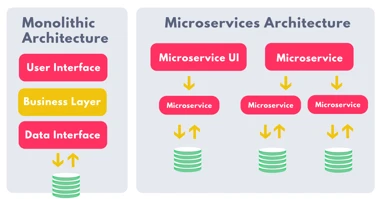In the ever-evolving landscape of information technology, staying ahead of the curve is essential for any company seeking to provide innovative and efficient solutions. One such groundbreaking concept that has gained immense popularity is the microservices architecture. This article aims to demystify what microservices are, delve into their advantages, and shed light on why adopting a microservices architecture can be beneficial for your IT projects.
What are Microservices
At its core, microservices architecture is a software development approach where an application is built as a collection of loosely coupled, independently deployable services. Each of these services encapsulates a specific business capability and operates as a separate unit, communicating with others through well-defined APIs. Unlike the traditional monolithic approach, where an application is a single, tightly interconnected unit, microservices break down complex applications into smaller, manageable components that can be developed, deployed, and scaled independently.
The advantages of the microservices architecture are manifold. One of the primary benefits is agility. With a monolithic architecture, any change or update to a single component could lead to the redeployment of the entire application. In contrast, microservices enable teams to work on individual services without disrupting the entire system. This not only accelerates development but also allows for rapid iteration and innovation.
What Microservices Architecture Really Means
To truly understand microservices architecture, let's consider an analogy. Think of a monolithic application as a giant, all-in-one department store where all the departments are interconnected. If one department needs renovation or faces an issue, the entire store might need to be closed down. On the other hand, microservices can be likened to a modern shopping mall, where each store operates independently. If one store needs maintenance, others can continue serving customers seamlessly.
In the microservices architecture, each service has its own database, its own logic, and may have its own development team. This isolation fosters a clear separation of concerns, making it easier to maintain and scale the application. Microservices also unleash the full power of modern development practices like continuous integration and continuous deployment (CI/CD), enabling teams to deliver updates faster and with higher quality.

Microservices Architecture vs Monolithic: Finding the Right Fit
While microservices architecture offers a plethora of benefits, it's crucial to recognize that it's not a one-size-fits-all solution. The decision between microservices and monolithic architecture depends on the specific requirements of your project.
Monolithic architecture works well for smaller projects with straightforward functionality. It's easier to develop, test, and deploy a monolithic application due to its centralized nature. However, as the application grows in complexity, a monolithic architecture can become a bottleneck, hindering agility and scalability.
Microservices shine when dealing with large, complex projects that require frequent updates and have distinct components with varying lifecycles. This approach allows multiple teams to work independently, reducing bottlenecks and promoting faster development. Microservices also enhance fault isolation, as a failure in one service doesn't necessarily bring down the entire application.

Pros and Cons of Microservices
Microservices architecture offers several advantages that make it a popular choice for designing and developing software applications, particularly in modern, fast-paced environments. Here are some of the key advantages of using microservices:
Scalability
Microservices allow individual components of an application to be scaled independently based on demand. This flexibility enables efficient resource utilization and cost savings.
Modularity and Maintainability
Microservices are small and focused on specific functionalities. This modularity makes it easier to develop, test, and maintain each service independently, reducing the risk of codebase complexity and "monolithic" code.
Faster Development and Deployment
Smaller codebases and independent development make it possible to release updates and new features more rapidly. Teams can work concurrently on different services, speeding up the development cycle.
Technology Agnosticism
Microservices architecture allows you to use different technologies and programming languages for different services, choosing the best tool for each specific task. This flexibility enables innovation and the adoption of modern technologies as needed.
Fault Isolation and Resilience
If one microservice fails, it doesn't necessarily impact the entire application. This isolation improves fault tolerance and resilience, as issues can be contained within individual services.
Improved Testing
Smaller, focused microservices are easier to test thoroughly. Unit testing, integration testing, and end-to-end testing can be performed more effectively, resulting in a more robust application.
Parallel Development
Teams can work on different microservices concurrently, reducing development bottlenecks and accelerating time to market.
Enhanced Team Autonomy
Microservices allow for smaller, cross-functional teams to own and manage specific services independently. This autonomy empowers teams to make decisions and iterate quickly.
Better Resource Utilization
Microservices can be optimized to use resources more efficiently, minimizing resource wastage compared to scaling an entire monolithic application.
Improved Fault Diagnosis
Microservices architectures often come with advanced monitoring and observability tools, making it easier to pinpoint and diagnose issues within the application.
Easy Integration with Third-Party Services
Microservices can be designed to interact with external services and APIs seamlessly, making it easier to integrate with third-party tools and services.
Enhanced DevOps Practices
Microservices encourage the use of DevOps practices like continuous integration and continuous deployment (CI/CD), automated testing, and containerization, leading to a more efficient development pipeline.
Scalable Development Teams
You can scale development teams based on the number of microservices, allowing organizations to grow and adapt to project requirements more flexibly.

Business Agility
The ability to change and adapt individual services independently enables faster response to changing business requirements and market conditions.
High Availability and Redundancy
Microservices can be deployed redundantly across multiple servers or data centers, enhancing availability and disaster recovery capabilities.
Cost Savings
Microservices can help optimize resource utilization, potentially reducing infrastructure and operational costs in the long run.
It's important to note that while microservices offer these advantages, they also come with their own set of challenges and complexities due to the next specifics.
Complexity
Microservices introduce a higher level of complexity compared to monolithic architectures. Managing a large number of independent services, orchestrating communication between them, and ensuring data consistency can be challenging.
Increased Development and Maintenance Overhead
Developing, testing, and deploying multiple microservices can be more time-consuming and resource-intensive than building a monolithic application. Each service requires its own codebase, testing, and deployment pipeline.
Distributed Systems Challenges
Microservices rely on network communication, which introduces issues such as latency, network failures, and potential service outages. Handling these challenges and ensuring reliability can be complex.
Data Management
Managing data consistency across multiple services can be tricky. Implementing distributed databases or maintaining data integrity in a microservices environment can lead to challenges in data management.
Operational Complexity
Microservices demand a robust DevOps and operational setup. Managing container orchestration (e.g., Kubernetes), service discovery, load balancing, and scaling can be complex and require additional skills and tools.
Initial Development Speed
Developing a microservices architecture may be slower initially due to the need for additional planning, design, and infrastructure setup.
Resource Overhead
Each microservice consumes system resources, including memory and CPU. Inefficient resource allocation or service scaling can lead to resource wastage.
Integration Testing Challenges
Integration testing can be more complex in microservices, as it involves testing interactions between multiple services. Coordinating and maintaining integration tests can be time-consuming.
Deployment and Versioning Complexity
Deploying and versioning microservices requires careful coordination to avoid service disruptions. Ensuring that clients use compatible service versions can be challenging.
Increased Network Traffic
Microservices communicate over the network, which can lead to increased network traffic, especially in cases with frequent inter-service communication.
Security Concerns
Securing microservices and their communication can be more complex than securing a monolithic application. Each service must be individually secured, and access control can be challenging.
Monitoring and Debugging
Monitoring and debugging microservices can be challenging, as logs and metrics may be distributed across multiple services. Tools for tracing and observability are often required.
Organizational Changes
Adopting microservices may require organizational changes, including team restructuring and changes in development processes, to support the decentralized nature of microservices.
Cost Considerations
While microservices can provide cost savings in terms of resource utilization, the initial setup and maintenance of a microservices infrastructure can be costly, especially for smaller projects.
It's important to note that many of these disadvantages can be mitigated with careful planning, good architectural design, and the right tools and practices. Microservices are not a one-size-fits-all solution, and their suitability for a project should be assessed based on the project's specific requirements and constraints. In some cases, a monolithic architecture or a hybrid approach may be more suitable.
Why Would a Microservices Architecture Be Beneficial
The benefits of adopting a microservices architecture are substantial and align well with the demands of modern IT projects. Businesses are under increasing pressure to deliver software faster, adapt to changing requirements, and ensure a seamless user experience. Microservices enable organizations to meet these demands by providing a framework that supports agility, scalability, and innovation.
Imagine you're building a comprehensive eCommerce platform. With a monolithic architecture, adding new features or services could be a lengthy process, involving extensive testing and risking system disruptions. On the other hand, by utilizing microservices, you could deploy new services independently, rapidly introducing features that enhance user engagement and drive sales.
In conclusion, microservices architecture has emerged as a transformative approach to software development, allowing organizations to overcome the limitations of monolithic systems. By breaking down applications into smaller, manageable components, microservices architecture promotes agility, scalability, and innovation. While the decision to adopt microservices should be based on the specific needs of your project, it's evident that this architecture offers a powerful solution for building and maintaining modern IT solutions.
In the fast-paced world of technology, staying ahead requires embracing innovative paradigms. Microservices architecture, with its ability to untangle complexities and streamline development, stands as a testament to the evolution of software engineering. As businesses continue to strive for excellence, the adoption of microservices could be the key to unlocking a future of efficient, scalable, and user-centric applications.

Glorious Examples of Microservices-based Architecture
Microservices have been successfully utilized by many organizations across various industries to achieve scalability, flexibility, and agility. Here are some examples of companies that have effectively implemented microservices.

Netflix
Netflix is often cited as a prime example of microservices architecture. They use a microservices-based approach to deliver their streaming service globally. Each microservice handles specific functionalities like user authentication, recommendations, and video streaming. This architecture enables them to scale rapidly and handle millions of users while maintaining a high level of uptime and personalized content recommendations.
Amazon
Amazon, the eCommerce giant, uses microservices extensively in its backend systems. For example, their retail platform is composed of numerous microservices responsible for different aspects of the shopping experience, such as inventory management, order processing, and payment processing. This architecture allows Amazon to handle massive traffic during peak shopping seasons.
Uber
Uber's ride-sharing platform is built on microservices. Each microservice handles specific tasks like user management, ride tracking, payment processing, and pricing algorithms. This architecture enables Uber to provide a seamless and reliable service to millions of riders and drivers worldwide.
Airbnb
Airbnb adopted microservices to scale its accommodation booking platform. They use microservices for various functions, including search, booking, payment processing, and host management. This approach allows Airbnb to quickly add new features and support a growing number of users and hosts.
Spotify
Spotify, the music streaming service, relies on microservices to deliver personalized music recommendations, playlists, and streaming capabilities. Their microservices architecture enables them to continuously update and optimize the user experience and handle a vast library of songs.
Twitter transitioned to a microservices architecture to improve the performance and scalability of its platform. Different microservices handle tasks like user timelines, tweet delivery, and notifications. This approach has helped Twitter handle spikes in user activity during major events.
Etsy
Etsy, an eCommerce marketplace for handmade and vintage items, utilizes microservices to power its platform. Each microservice focuses on specific functions, such as product search, listing management, and checkout. This architecture allows Etsy to support a diverse range of sellers and products.
LinkedIn employs microservices to deliver its professional networking platform. Microservices handle features like user profiles, connections, job recommendations, and messaging. This architecture enables LinkedIn to scale its services and introduce new features efficiently.
Groupon
Groupon's daily deal platform relies on microservices to handle user accounts, deal listings, purchases, and notifications. Microservices enable Groupon to deliver personalized deals to millions of subscribers worldwide.
Walmart
Walmart, one of the world's largest retailers, uses microservices to enhance its online shopping experience. Microservices manage aspects like product catalog, inventory, order processing, and fulfillment. This approach helps Walmart compete effectively in the eCommerce space.
These examples demonstrate that microservices can be effectively applied across various domains to improve scalability, maintainability, and development speed while providing a reliable and responsive user experience. However, it's important to note that the success of microservices depends on proper design, implementation, and ongoing management.
How to implement microservices into software products?
Implementing microservices into a software product involves breaking down a monolithic application into smaller, more manageable services that can be developed, deployed, and scaled independently. Here are the steps to implement microservices effectively:
Define Your Goals and Strategy:
-
Clearly understand why you want to adopt microservices. Common goals include scalability, agility, easier maintenance, and faster development.
Decompose Your Monolith:
-
Analyze your existing monolithic application to identify logical boundaries for breaking it into smaller services. Each service should have a specific, well-defined responsibility.
Select Technologies and Tools:
-
Choose appropriate technologies and tools for building, deploying, and managing microservices. Common choices include containers (e.g., Docker), orchestration platforms (e.g., Kubernetes), and service mesh frameworks (e.g., Istio).
Design Your Microservices:
-
Design the architecture of each microservice, including its APIs and data storage mechanisms. Consider using RESTful APIs, GraphQL, or other communication protocols.
Establish Communication Patterns:
-
Decide how microservices will communicate with each other. Common approaches include synchronous HTTP calls (REST), asynchronous messaging (e.g., Kafka or RabbitMQ), and gRPC for high-performance communication.
Implement and Deploy Microservices:
-
Develop each microservice independently, following best practices for its chosen technology stack. Deploy services using containerization and orchestration tools for easy scaling and management.
Set Up Monitoring and Logging:
-
Implement robust monitoring and logging solutions to track the health and performance of your microservices. Tools like Prometheus and Grafana can help with this.
Implement Load Balancing and Scaling:
-
Configure load balancing to distribute traffic across multiple instances of each microservice. Use auto-scaling mechanisms to handle varying workloads.
Ensure Data Management and Consistency:
-
Decide how data will be managed and shared between microservices. Consider databases, caching, and eventual consistency mechanisms like the Saga pattern or distributed transactions.
Security and Authentication:
-
Implement proper security measures, including authentication and authorization for each microservice. Centralized identity and access management can be useful.
Testing and Quality Assurance:
-
Implement a robust testing strategy that includes unit testing, integration testing, and end-to-end testing for your microservices. Implement continuous integration and continuous deployment (CI/CD) pipelines.
Error Handling and Resilience:
-
Design your microservices to be resilient to failures. Implement error handling and retries to ensure that the system remains responsive even when some components fail.
Documentation and API Gateway:
-
Create clear and comprehensive documentation for each microservice's API. Consider using an API gateway to manage API requests and versioning.
Deployment and Rollout:
-
Plan the deployment of your microservices in stages, starting with less critical services. Monitor and test thoroughly during each stage to minimize disruptions.
Monitoring and Optimization:
-
Continuously monitor the performance and health of your microservices. Optimize as needed to improve efficiency, scalability, and resource utilization.
Team Organization and Culture:
-
Foster a culture of ownership and accountability among development teams responsible for different microservices. Encourage collaboration and knowledge sharing.
Feedback Loop and Iteration:
-
Establish a feedback loop to gather insights from production and end-users. Use this feedback to iterate on your microservices architecture and improve the product.
Remember that transitioning to a microservices architecture can be complex and may require organizational changes, but when implemented correctly, it can offer significant benefits in terms of scalability, agility, and maintainability for your software product.
Conclusion
In the ever-evolving landscape of software architecture, microservices stand as a beacon of innovation and adaptability. Throughout this journey into the realm of microservices, we've unraveled the threads that weave together the fabric of modern software development.
From scalability that adapts to the beat of your business's heart to the resilience that keeps your services afloat, microservices offer a blueprint for building robust, responsive, and maintainable software systems. The advantages are compelling—faster development, improved resource utilization, and the ability to pivot with the speed of a startup, even if you're a well-established enterprise.
But, as with any technological breakthrough, the power of microservices comes with its own set of challenges. It's a world where collaboration, communication, and orchestration reign supreme. It's a world where the sum is greater than the parts, but each part plays a pivotal role in the grand symphony of your software ecosystem.
So, as you embark on your microservices journey, remember that it's not just about the architecture—it's about the mindset, the culture, and the dedication to delivering top-notch user experiences. It's about understanding that while microservices offer a path to scalability and agility, they require careful planning, robust monitoring, and continuous refinement.
In a world where change is the only constant, microservices are your ticket to staying ahead of the curve. They're the engines of innovation that can propel your organization into the future of software development. Embrace them, harness their power, and unlock a world where your software can thrive, adapt, and conquer.
Welcome to the age of microservices, where the possibilities are as limitless as your imagination and as dynamic as your ambition. The future of software architecture is here, and it's microservices.
Contacts
-
Book a call Appointment - USA Appointment - USA -
Book a call Appointment - EU Book a call
Appointment - EU -
Whatsapp Talk to CEO Whatsapp
Talk to CEO -
Write to us hi@ukad-group.com Write to us
hi@ukad-group.com


